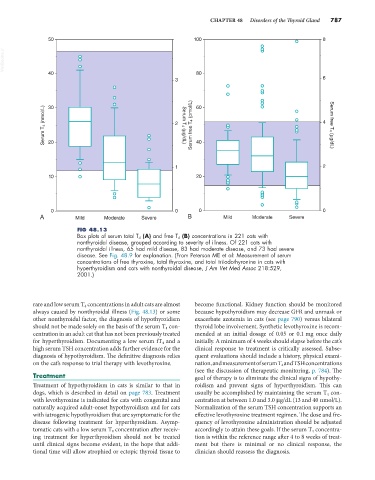Page 815 - Small Animal Internal Medicine, 6th Edition
P. 815
CHAPTER 48 Disorders of the Thyroid Gland 787
50 100 8
VetBooks.ir
40 80
3 6
Serum T 4 (nmol/L) 30 2 Serum T 4 (µg/dL) Serum free T 4 (pmol/L) 60 4 Serum free T 4 (µg/dL)
40
20
1 2
10 20
0 0 0 0
A Mild Moderate Severe B Mild Moderate Severe
FIG 48.13
Box plots of serum total T 4 (A) and free T 4 (B) concentrations in 221 cats with
nonthyroidal disease, grouped according to severity of illness. Of 221 cats with
nonthyroidal illness, 65 had mild disease, 83 had moderate disease, and 73 had severe
disease. See Fig. 48.9 for explanation. (From Peterson ME et al: Measurement of serum
concentrations of free thyroxine, total thyroxine, and total triiodothyronine in cats with
hyperthyroidism and cats with nonthyroidal disease, J Am Vet Med Assoc 218:529,
2001.)
rare and low serum T 4 concentrations in adult cats are almost become functional. Kidney function should be monitored
always caused by nonthyroidal illness (Fig. 48.13) or some because hypothyroidism may decrease GFR and unmask or
other nonthyroidal factor, the diagnosis of hypothyroidism exacerbate azotemia in cats (see page 790) versus bilateral
should not be made solely on the basis of the serum T 4 con- thyroid lobe involvement. Synthetic levothyroxine is recom-
centration in an adult cat that has not been previously treated mended at an initial dosage of 0.05 or 0.1 mg once daily
for hyperthyroidism. Documenting a low serum fT 4 and a initially. A minimum of 4 weeks should elapse before the cat’s
high serum TSH concentration adds further evidence for the clinical response to treatment is critically assessed. Subse-
diagnosis of hypothyroidism. The definitive diagnosis relies quent evaluations should include a history, physical exami-
on the cat’s response to trial therapy with levothyroxine. nation, and measurement of serum T 4 and TSH concentrations
(see the discussion of therapeutic monitoring, p. 784). The
Treatment goal of therapy is to eliminate the clinical signs of hypothy-
Treatment of hypothyroidism in cats is similar to that in roidism and prevent signs of hyperthyroidism. This can
dogs, which is described in detail on page 783. Treatment usually be accomplished by maintaining the serum T 4 con-
with levothyroxine is indicated for cats with congenital and centration at between 1.0 and 3.0 µg/dL (13 and 40 nmol/L).
naturally acquired adult-onset hypothyroidism and for cats Normalization of the serum TSH concentration supports an
with iatrogenic hypothyroidism that are symptomatic for the effective levothyroxine treatment regimen. The dose and fre-
disease following treatment for hyperthyroidism. Asymp- quency of levothyroxine administration should be adjusted
tomatic cats with a low serum T 4 concentration after receiv- accordingly to attain these goals. If the serum T 4 concentra-
ing treatment for hyperthyroidism should not be treated tion is within the reference range after 4 to 8 weeks of treat-
until clinical signs become evident, in the hope that addi- ment but there is minimal or no clinical response, the
tional time will allow atrophied or ectopic thyroid tissue to clinician should reassess the diagnosis.

